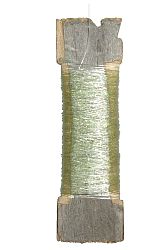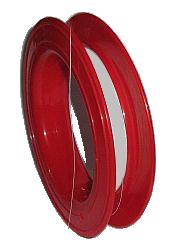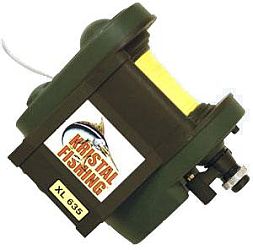- Home Page
- Accessories
- Kite Reel
The Kite Reel
Bits of Stick and Multi-Drum Winches
So it's a page all about The Kite Reel. A bit mundane, do you think? But hey, I managed to dig up a few things that prompted a chuckle or two! For instance, take the extremes:
 A winding handle is handy
A winding handle is handyAt one end, you have people who are willing to use a pencil or a stick as a reel!
I can only assume these people have flown nothing bigger than a 30 centimeter (12 inch) kite and on a line no longer than 20 meters (70 feet) or so. Wouldn't that drive you nuts, winding in a kite on something with such a small diameter. The funny thing was (according to an online comment I saw), one guy saw it as a plus! For him, getting a kite in slowly added to the fun.
Each to his own, as they say.
At the other end, there are people out there who are serious about their reels. Take the kite-fishing crowd. Some of these people seem to have far too much disposable income, being willing to part with hundreds of dollars for an electric reel!
I won't dwell on this curious corner of the kite-flying world but had to at least mention it, since the electric reel is genuinely designed for operating a kite. Here's a specific example that I once saw: The Kristal 635 Variable Speed Kite Reel, being offered for the low promotional price of US$400. I'm sure it worked great, but don't expect to see one down at the beach with a colorful delta on the end of the line. :-|
On this site, there's more kite-making info than you can poke a stick at. :-)
Want to know the most convenient way of using it all?
The Big MBK E-book Bundle is a collection of downloads—printable PDF files which provide step-by-step instructions for many kites large and small.
Every kite in every MBK series.
In between the two extremes mentioned above would be the typical round winder with a hand grip.
A little note about terminology: I used to think "reels" were round and "winders" were flat, but it seems the terms are fairly interchangeable these days. Perhaps the word "reels" is used more exclusively for circular or cylindrical devices, but the term "winder" seems to be applied to just about anything used for storing line.
Extremes aside, it seems the world of kite reels can be roughly divided up into three parts:
Cheap and Handy Kite Reel
Here we have the masses of sticks, toilet rolls, old discarded fishing reels and so on that do the job for small very cheap kites and short lines. These people are just after something very quick and handy—not to mention absolutely free. Interestingly, the popularity of fishing reels never seems to wane. Indeed, that is exactly what I used as a child when flying my own crude diamond kites!
The photo shows one of our winders from the early days of this website. It's a perfect example of cheap and handy! It's just a small piece of wood I found lying around that was then shaped by using a wood file.
 Quick and rough
Quick and roughWhew, removing wood with a file is a bit of a job. Using a saw of some kind is a much better idea, followed by some filing and sanding to finish off. That's much easier!
The line on this winder is 3-kilogram monofilament fishing line. It was great for our little 1-Skewer kites but wasn't without its problems when used like this. Fishing line works best where it was designed to reside—on fishing reels! We later moved on to Dacron line of various weights for all our kites.
Now, I have an idea for the ultimate cheap and handy kite reel. Here's the feature list:
- suits up to 15 meters of 10-pound line
- lockable with special curling action
- lightweight and compact
- natural finish, self-regenerating
- comes with nine replacements in assorted sizes
- will never get lost due to permanent attachment feature
- full lifetime guarantee
- 100% FREE
Isn't that amazing; it's your finger! ;-)
Typical Shop-Bought Kite Reel
Moving just a little upmarket, there are numerous inexpensive devices on the market that cater for those $50 single-line kites, give or take a few tens of dollars. You know, the kind that are hung all over the walls of your local kite shop. For example, there are medium sized and attractively decorated deltas, diamonds, and even the smaller cellulars. Flying one of these on more than 50 meters of line just isn't practical on something with a small diameter like a pencil. The ability to let out line reasonably quickly is more important with these kites.
 Our plastic Halo reel
Our plastic Halo reelThe Halo reel is a tough plastic device with deep sides to keep the line in place. There's ours in the photo, with some 20-pound line on it. It's comfortable to grip while flying and easy to wind line on with reasonable speed.
However, to let out line very quickly, you need a modified design such as the also popular Yo Yo. This reel can be laid on the ground, with its slanted surface letting the line fly off rapidly if required. That's great for kite fighting, where contestants often need to reel in and let out a lot of line in a short space of time!
For even more convenience, there is another whole class of reels that come mounted on a solid frame. The frame is braced against your body, and a handle on the side of the reel makes winding-on a cinch. Since the reel rotates on a pivot, letting out line is easily controlled by using your hand on the rim as a brake. On some designs you don't even need to use your hand, since the friction of rotation can be adjusted while you fly. There's no danger of line burns here, since you don't need to actually touch the line at any time from launch to landing! There's a picture of one of these right at the top of this page—used with permission, thanks to the people at coastalkites.com.
A good reel will also come equipped with a lock of some sort, so when the kite is high enough you can prevent any more line going out. Some setups use interchangeable reels, giving you the option of storing different lines for flying different kites. Or perhaps the feature is for flying the same kite in different wind conditions!
All these reels come in a variety of sizes and colors, no doubt in response to demand from the kite-buying public.
Specialist Reels and Winches
This is a very diverse group of kite reels. These people are either kite fishing, putting up fairly large shop-bought or home-built single-liners, breaking altitude records, or using very large kites for some other purpose than recreation.
Kite fishing has been touched on already, with its commercially available electric winders.
 Pricey: a motorized fishing reel
Pricey: a motorized fishing reelThere's one in the photo, which weighs less than 2 kilograms (4 pounds) and is designed to be taken out on a boat. The photo is used with permission from the people at bluemarlinchronicles.com.
However, the other devices in this group tend to be custom made, engineered for just one purpose or even just one kite. There are complete winches in some cases!
I can remember looking at photos of one guy's gear for breaking altitude records. His delta looked like an aircraft! The kite winch had to meet requirements such as the following:
- Be strong enough to withstand the huge tension forces of a very large kite.
- Be able to wind on to a line-storage drum with much-reduced tension, while reeling in the kite. This required two drums. One was for high-tension anchoring of the kite, and the other was fed line for storage.
- A drive motor and mechanicals were required for winding in.
- Effective braking capability was needed, to control letting-out.
As mentioned earlier, there's more kite making on this site than you can poke a stick at. :-)
Want to know the most convenient way of using it all?
The Big MBK E-book Bundle is a collection of downloads—printable PDF files that provide step-by-step instructions for many kites large and small.
That's every kite in every MBK series.
